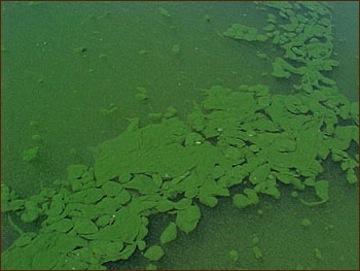330114-making oxygen.jpg

Cyanobacteria bloom. Credit: USGS
Every time you take a breath, you’re drinking in life-giving oxygen. When our planet was born, though, the atmosphere contained almost no oxygen at all. Oxygen was first pumped into the atmosphere billions of years ago – by microscopic organisms in the oceans. Cyanobacteria were the first organisms on Earth to use photosynthesis. They combined sunlight with carbon dioxide, sea water, and nutrients to create the food that sustained them. This process also produced oxygen, which was released into the water. Some of the oxygen eventually made its way into the air.
Recent research says that cyanobacteria may have been adding small amounts of oxygen to the atmosphere as early as three billion years ago. But large amounts didn’t start showing up until less than two-and-a-half billion years ago.
There are several possible explanations for the delay. One says that a lot of iron was dissolved in the sea water. As the cyanobacteria began to produce oxygen, it combined with the iron molecules to produce iron oxide. This sank to the bottom, forming beds of iron ore. According to this idea, only after the iron in the water was used up did the oxygen begin to escape the oceans and enter the atmosphere.
However it got there, the oxygen made possible the development of the oxygen-breathing organisms that fill our world today – everything from sharks to kangaroos to people. And we’re all breathing oxygen produced by other organisms – the grass and trees on land, and the cyanobacteria that still populate the world’s oceans.

